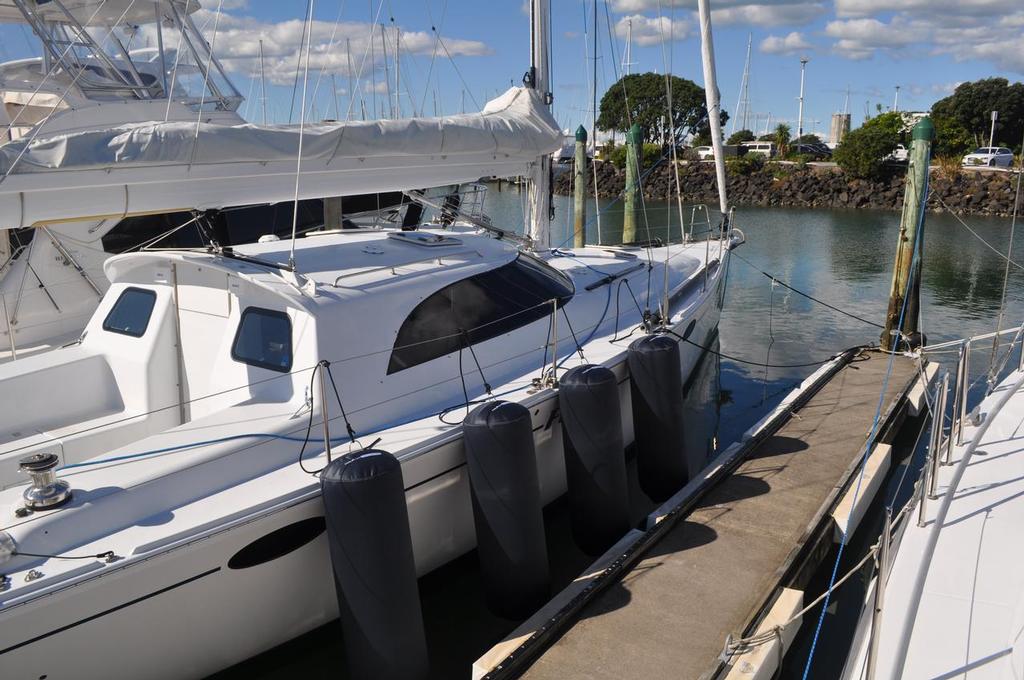Hauraki Fenders- Taking New Zealand by storm
by Sail-World.com on 15 Mar 2015

Hauraki Fenders on the Elliott Tourer 1350 SW
For a country that takes pride in being one of the world leaders in the marine industry, there are some areas where New Zealand is playing catch up. Fenders for pleasure craft is one such area.
New Zealand appears to be stuck in the days when undersized, permanently inflated fenders were an accepted way to protect a boat’s topsides. But the world has moved on, and New Zealand hasn’t. Large inflatable fenders are now the norm in most parts of the world, in particular, the USA, the Mediterranean and Europe.
Inflatable fenders are the obvious fender solution once you understand how they work and the benefits of them.
While sitting at anchor you will often see people rafted up together having to fend their boats off whenever a large launch wake comes through a bay because their fenders are too small. That doesn’t make for a relaxing day as people can’t leave their boats for fear of them being damaged. The main reason people don’t have properly sized fenders is they can’t store them easily as they don’t have the space available on board.
Inflatable fenders solve that problem. You can have a large, properly sized fender when inflated, that you can deflate, roll up and store away easily while taking up very little space. These fenders have not made it into the New Zealand marine scene with any great significance until Hauraki Fenders was formed.
Hauraki Fenders is the brain child of husband and wife team Damon and Jacqui Jolliffe and leapt onto the Auckland marine scene in the mid-2014.
They have quickly gone from strength to strength. When asked how Hauraki Fenders came to be Damon Jolliffe replied: 'We understood the benefits of these fenders as they just make so much sense, and we quickly discovered they weren’t readily available in New Zealand.
'So we extensively researched what was already available in overseas markets. We combined everything we learnt and made a superior product.
'We went with an online business model so we don’t have the high overheads that are associated with operating a standard bricks and mortar outlet and we also offer our products directly to the customer; this removes the mark ups that are added by retailers and other intermediaries.
'Combining these three elements has created an unbeatable formula as the customer gets a premium product for a lower cost.'
Hauraki Fenders have been very well received.
'We have had an amazing response for our fenders, and this confirmed our suspicions that New Zealand boaties were just waiting for this product to be put in front of them,' Damon adds.
'In particular for the large inflatable series fender, there was so much demand that we ran out of stock well before we expected and had a number of back orders to fill'.
The Inflatable Series Hauraki Fenders are constructed from heavy duty, 1.2mm thick PVC fabric that is thicker than most other inflatable fenders that are only 0.9mm thick.
The seams are heat welded together with doubler tapes in a controlled environment to ensure a strong, high-quality join is achieved.
Each fender has two reinforced stainless steel D-ring attachment points, one at each end. This allows every fender to be hung either horizontally or vertically. The fenders are fitted with a standard inflatable boat inflation/deflation valve.
Either a normal inflatable boat pump or a small electric pump can be used to inflate the fenders. The fenders can be easily deflated and rolled up to a compact size for easy storage.
With products to suit all types of vessels from a 20ft yacht to the 100ft Supermaxi Rio 100 which underwent a major refit by Cookson Boats last year, Hauraki Fenders has an option for everyone. But don’t think that an inflatable fender is just for fending off other boats in a raft up or at a dock!
Hauraki Fenders customers use their fenders for everything from floatation devices inside sailing dinghies, to racing marks and buoys, to water toys, to air-bags to rest tenders.
As well as doing inflatable fenders, Hauraki Fenders also offer a range of fender covers for their products.
The fender covers are made are from a tough interlocking polyester fabric that has unique stretching capabilities to create a snug fitting fender cover. They are tough wearing and look great.
If you are going to use your fenders a lot, then covers are definitely recommended. Damon explains: 'The covers serve two main purposes: to protect the fenders from the UV that as we all know is particularly harsh in New Zealand; and to protect them from being damaged by any abrasive surfaces'
With a fender solution perfect for any size boat, and for any purpose, whether you are cruising the far North or exploring Fiordland, Hauraki Fenders has the ultimate fender solution for you!
For more information on Hauraki Fenders and their products, please visit their website www.haurakifenders.co.nz
If you want to link to this article then please use this URL: www.sail-world.com/132470